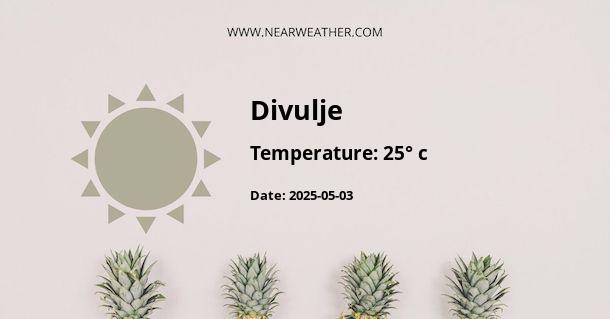Understanding the Climate and Weather Patterns of Divulje, Croatia
Divulje, a picturesque location in Croatia, features a climate influenced by its position along the Adriatic Sea. The weather patterns experienced in Divulje are characteristic of a Mediterranean climate with some nuances owing to local topography and sea currents. In this comprehensive guide, we will delve into the specifics of Divulje's climate, examining temperature ranges, precipitation levels, seasonal variations, and extreme weather events, utilizing statistical data and research to provide a thorough understanding.
Temperature Patterns in Divulje
Divulje's Mediterranean climate ensures generally mild winters and warm to hot summers. In the analysis of temperature patterns, we will consider both average high and low temperatures throughout the year. The data segments into four distinct periods: winter (December-February), spring (March-May), summer (June-August), and autumn (September-November).
| Month | Average High (°C) | Average Low (°C) |
|---|---|---|
| January | 12 | 5 |
| February | 13 | 6 |
| March | 16 | 8 |
| April | 19 | 11 |
| May | 24 | 15 |
| June | 28 | 19 |
| July | 31 | 22 |
| August | 31 | 22 |
| September | 27 | 18 |
| October | 22 | 14 |
| November | 17 | 9 |
| December | 13 | 6 |
As we can see from the table above, the warmest period is during the summer months when temperature highs can soar into the low 30s (°C), providing ideal conditions for enjoying the coastal environment. Winters remain comparatively mild with temperatures rarely dropping below freezing.
Precipitation and Seasonal Weather Events
Precipitation in Divulje is fairly distributed throughout the year, with a slight increase during autumn and winter months. Let's take a closer look at monthly precipitation patterns.
| Month | Average Precipitation (mm) |
|---|---|
| January | 82 |
| February | 75 |
| March | 77 |
| April | 63 |
| May | 47 |
| June | 37 |
| July | 26 |
| August | 42 |
| September | 70 |
| October | 101 |
| November | 86 |
| December | 96 |
From the data, it is evident that October tends to be the wettest month, with a notable increase in rainfall. Divulje may experience occasional heavy rain events that can lead to localized flooding, especially during this wetter part of the year. In contrast, the summer months are typically drier, coinciding with peak tourist season.
"Divulje, with its coastal Mediterranean climate, offers a pleasurable environment with a balance of warm, sun-filled summers and mild, moist winters, which has played a critical role in its rise as a tourist destination." - Croatian Meteorological and Hydrological Service.
Seasonal Wind Patterns
Beyond temperatures and precipitation, winds are a defining feature of the climate in Divulje. Two primary winds dictate the local weather: the 'Bura' and the 'Jugo'.
- Bura: A cold, northerly wind that is most common during the winter months. It can bring clear skies but also significantly cooler temperatures and rough sea conditions.
- Jugo: A southeastern wind known for its humidity and warmth. It often precedes low-pressure systems and is associated with unsettled weather patterns, including storms and rain, particularly in the autumn and spring.
Understanding these wind patterns is essential for both the maritime industry and for visitors planning outdoor activities.
Extreme Weather and Climate Events
While Divulje's climate is predominantly mild, it's not immune to extreme weather events influenced by climate change. In recent years, the region has seen an increase in the frequency and intensity of heatwaves during the summer months. These events pose significant health risks, particularly to vulnerable populations.
Conversely, harsh winter storms, while less common, can occur, with heavy rainfall and strong Bura winds, resulting in turbulent sea conditions and potential impacts on infrastructure.
Climate Change Implications
Climate change is an overarching concern that is progressively altering weather patterns worldwide, and Divulje is no exception. Research suggests that the Mediterranean region is particularly susceptible to climatic shifts, manifesting in hotter, drier summers and a potential increase in extreme weather events.
"The vulnerability of the Mediterranean region to climatic variations presents challenges for sustainable development, including water resource management, agriculture, and biodiversity conservation." - Intergovernmental Panel on Climate Change (IPCC)
Local authorities and organizations in Divulje and the wider Croatian region are actively working towards adaptation and mitigation strategies to address these evolving climatic conditions.
Year-Round Climate Overview of Divulje
Summarizing the climate in Divulje:
- Winter: Mild temperatures with increased precipitation.
- Spring: Pleasantly warming with moderate rainfall.
- Summer: Hot and dry, ideal for coastal tourism.
- Autumn: Cooler with the wettest months of the year.
In conclusion, Divulje offers a relatively stable Mediterranean climate which is enjoyable throughout the year. It is important for tourists and locals alike to remain aware of seasonal variations, as well as the potential for extreme weather events, to fully appreciate and prepare for this beautiful Adriatic locale.
Whether one's interest lies in maritime activities, agriculture, or simple leisure, understanding Divulje's specific climate and weather nuances is both valuable and necessary. With ongoing research and attention to the implications of climate change, Divulje can continue to be appreciated for its distinct meteorological profile.
A - Divulje's Latitude is 43.527222 & Longitude is 16.294720.
A - Weather in Divulje is 19° today.
A - Climate Conditions in Divulje shows overcast clouds today.
A - Humidity in Divulje is 82% today.
A - Wind speed in Divulje is 14.83 km/h, flowing at 130° wind direction. today.
